|
|
|||
|
(Back to Preceding Week; on to Next Week) |
|
|
|
WHITE HUMMINGBIRDS 2007:
ALBINOS & LEUCISTOS Ruby-throated Hummingbirds--and the other 328 or so species of Trochilids--are truly fascinating creatures. Hummers are the only birds that can hover and fly backwards for extended periods; they have long, thin bills and feathery edged tongues adapted for lapping up flower nectar; they come readily to feeders stocked with sugar water; and most species in the U.S. and Canada migrate rather long distances to Mexico or Central America during their non-breeding season--often returning to their natal areas the next spring. And did we mention many hummers are only about as big as an adult human's thumb? Yes, hummingbirds are indeed fascinating for all the reasons above, but if that's not enough they still drop delightful surprises on us--as when a western vagrant species shows up "out of range" in the eastern U.S. Perhaps the biggest and most enjoyable experience, however, occurs if a white hummingbird unexpectedly shows up at the backyard feeder. Although we've had western vagrants--two different Rufous Hummingbirds--at Hilton Pond Center, we've never hosted a white hummer, but other folks have. Some of these observers have been gracious enough to send photos of their aberrant-plumaged birds, so this week we wanted to share the best of these 2007 images of ghostly white hummingbirds from around the country.
All text & photos © Hilton Pond Center For many years dear friend Ellie Womack--a long-time bander from Grove OK--kept track of reports of light-colored hummers, so we dubbed her Queen of the White Hummingbirds. With the advent of the Internet and digital photos, her royal duties became nearly overwhelming and Ellie decided to abdicate her throne. We suspect there aren't any more white hummers today than before, but the world hears about them much more often thanks to modern technology. Our own favorite experience with white hummers was a true albino Ruby-throated Hummingbird that appeared in Durham NC a few years ago (above). We were able to trap and photograph this incredible bird and, to our knowledge, it became the first albino ruby-throat ever banded. Amazingly, a week or so later a second albino ruby-throat showed up not far away in Raleigh, and North Carolina bander Susan Campbell--who had been present to watch our banding in Durham--got to catch her own pristine white bird.
We've banded several other white hummingbirds, but none were true albinos. For a bird to be albinistic, it must be lacking in all pigment; in the case of hummers, that means there is no melanin, the black pigment. Curiously, in normal Ruby-throated Hummingbirds there is no red or green pigment--even though those metallic colors are predominant. Color in hummers is structural, i.e., tiny grooves and bubbles in the feathers scatter light and make it look green or red. Light has to hit the feathers--whose base color is black from the melanin--at just the right angle to produce metallic colors, so if an adult male ruby-throat with a brilliant gorget turns his head the "wrong" way (above), its throat appears black instead of iridescent red.
Albino hummingbirds still have air bubbles and grooves in their plumage, but without underlying melanin scattered light is invisible and the bird appears white. The final clue to true albinism comes when one sees the eye, bill, and feet of the bird in question. If it's a true albino, those structures also lack melanin pigment and appear pink or orange-pink (above)--the color the result of red hemoglobin within the retina or in tissue of the bill and foot.
Incidentally, the photo above left shows another interesting characteristic of the Ruby-throated Hummingbird's wing: The "subalular apterium," a naked spot at the bend of the wing just behind the alular feather. One of the most interesting and least understood aspects of leucistic hummingbirds is that their plumage--occasionally all white--more often is some shade of tan or light gray; some individual leucistos are even "piebald," with white areas mixed in among plumage that is otherwise normal. (For the record, we DO like the word "leucisto," but we are NOT asking "piebaldo" to be used for hummers that have spots.) Frequently there is even a hint of standard markings on a leucistic hummer, as shown in the photo (above right) of the tail of a juvenile female ruby-throat we banded at Bethany SC. As mentioned, we've never been fortunate enough to get a white hummingbird here at Hilton Pond Center, but other folks have and thanks to their generosity we're sharing some images they e-mailed to us. We don't have room for all the reports, so we're posting a representative sampling to show just how varied were this year's surprising white hummingbirds--both albinos and leucistos, and piebalds, too. WHITE HUMMINGBIRD GALLERY 2007 NOTE 1: All photos are the property of their respective photographers and may NOT be used without written permission. NOTE 2: We're not positive of the species on the western hummingbirds illustrated #3 & #5). If you have suggestions on identification for either of these, please e-mail us at INFO. NOTE 3: It's interesting that ALL the white Ruby-throated Hummingbird photos below were taken in late summer. From this it's logical to conclude these are young birds, especially when we mention that, to our knowledge, all albinistic and leucistic ruby-throats that have been banded were recent fledglings and none returned in a later year. (Most white hummers also appear to bve females.) Hummingbirds with aberrational plumage may have a lower survival rate because they are more obvious to predators, because of possible genetic defects associated with abnormal coloration, or because their white feathers--devoid of melanin that strengthens normal plumage--just plain wears out in migration. (We know of only one report of an albino hummingbird in spring--and that was for a western species that might be sedentary rather than migrational.) NOTE 4: If you have photos of other hummingbird albinos or leucistos that appeared in 2007, please e-mail them to RESEARCH. Be sure to include city/state, photographer's name, and date of photo. Thanks to everyone who contributed the images included below. NOTE 5: For a thought-provoking discussion of aberrational plumages, see Jeff Davis's "Color Abnormalities in Birds: A Proposed Nomenclature for Birders" in the Sep/Oct 2007 issue of Birding magazine.
#1: Leucistic Ruby-throated Hummingbird at Milton FL on 11 September 2007. Photo by Penny Dillon
#2: Leucistic Ruby-throated Hummingbird at Buchanan TN (near Paris Landing State Park on Kentucky Lake) on 19 September 2007. Photo by Ken Sloan.
#3: Leucistic hummingbird at Chapel Hill TX on 16 September 2007. Photo submitted by Stacy Canion (taken by her mom).
#4: Leucistic Ruby-throated Hummingbird at Pacific MO on 9 September 2007. Photo taken by Bonnie Hopper on behalf of her mother, Donna Molinet).
#5: This partly white hummingbird--a "piebald" rather than a leucisto--was at Redstone One Campground, Redstone CO, along the Crystal River in June 2007. Photo by Dennis Slater.
#6: Albino Ruby-throated Hummingbird on 13 September 2007 at St. Robert MO. Photo by Alexander Stevens.
#7: Piebald adult male Black-chinned Hummingbird (the western counterpart of the Ruby-throated Hummingbird) at Pima AZ in April 2007. Photo by Susan Lynnes.
#8: Slightly damp albino Ruby-throated Hummingbird at Watertown WI on 4 September 2007. Photo by Cheryl Herold.
#9: Ruby-throated Hummingbird leucisto at Folsom LA on 31 July 2007. Although this bird appears to have the pink eye of an albino, it's actually the "red eye" effect of light from a camera flash bouncing off the retina when the bird's pupil is wide open. Photo by Sgt. Merrill Smith. All text & photos © Hilton Pond Center Please e-mail additional reports of white hummingbirds to RESEARCH.
Comments or questions about this week's installment?
Thanks to the following fine folks for recent gifts in support of Hilton Pond Center for Piedmont Natural History and/or Operation RubyThroat: The Hummingbird Project. Your tax-deductible contributions allow us to continue writing, photographing, and sharing "This Week at Hilton Pond." (Please see Support if you'd like to make a gift of your own.)
IMPORTANT NOTE: If you ever shop on-line, you may be interested in becoming a member of iGive, through which nearly 700 on-line stores from Barnes & Noble to Lands' End will donate a percentage of your purchase price in support of Hilton Pond Center and Operation RubyThroat. For every new member who signs up and makes an on-line purchase iGive will donate an ADDITIONAL $5 to the Center. Please sign up by going to the iGive Web site; as of this week, 197 members have signed up to help Hilton Pond Center. It's a painless, important way for YOU to support our work in conservation, education, and research. "This Week at Hilton Pond" is written & photographed You may wish to consult our Index of all nature topics covered since February 2000. You can also use our on-line Hilton Pond Search Engine at the bottom of this page. For a free, non-fattening, on-line subscription to |
|
Make direct donations on-line through
Network for Good: |
|
|
LIKE TO SHOP ON-LINE?
Donate a portion of your purchase price from 700+ top on-line stores via iGive: |
|
|
Use your PayPal account
to make direct donations: |
|
|
SPECIES BANDED THIS WEEK: * = New species for 2007 WEEKLY BANDING TOTAL 12 species 84 individuals YEARLY BANDING TOTAL (2007) 59 species 1,343 individuals 26-YEAR BANDING GRAND TOTAL (since 28 June 1982) 124 species 49,426 individuals NOTABLE RECAPTURES THIS WEEK (with original banding date, sex, and current age) Carolina Chickadee (1) American Goldfinch (1) Northern Cardinal (1) White-throated Sparrow (3) Downy Woodpecker (1)
|
OTHER NATURE NOTES OF INTEREST --After a horrendously hot August and too-warm September, we finally had a cold snap as Halloween approached and temperatures dropped into the 40s. Better news was the 1.4" of rain that fell this week at Hilton Pond Center--the first of significance since mid-summer. This slow, steady, all-day downpour soaked completely into the soil; there was so little run-off the depth of Hilton Pond itself scarcely changed. --An Ovenbird banded at the Center on 23 Oct was quite tardy for the species, our previous late migrant having appeared on 7 Oct 1984.
--A big female Cooper's Hawk (above) that has been catching birds around Hilton Pond got a taste of her own medicine this week when she bumbled into a mist net while pursuing a flock of White-throated Sparrows. This was only our second-ever Cooper's banded at the Center since 1982, the first occurring in Nov 2004. Based on breeding bird censuses and winter counts, Cooper's Hawks appear to be on the increase in the Carolinas.
|
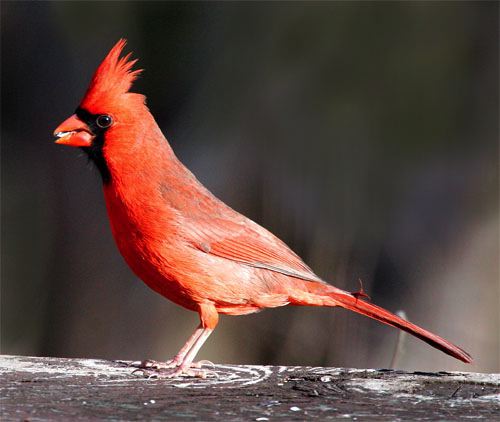
Male Northern Cardinal (above) in adult winter plumage AN EXPLOSION OF During the past two months at Hilton Pond Center we've banded nearly 50 Northern Cardinals (NOCA)--almost all HY birds with a nearly even mix of males and females. Thirty-two (32) have been banded in October alone. During 25 years of banding at the Center we've never had such a large autumn influx of NOCA; in fact, on average we band only 78 annually. In the years since 1982, NOCA increased as the Center's property went through natural succession, reaching a peak in the early and mid-1990s when small trees and shrubs provided dense shelter and nesting cover; numbers have declined steadily during the past decade, likely because the local shrub layer got shaded out by ever-taller trees. At first we thought this year's bumper crop of NOCA was simply a "fall shuffle," with birds immigrating from nearby breeding sites. We're no longer sure that's a correct interpretation. It's hard to imagine all these birds--seven new ones on 22 Oct--are fanning out from natal areas close to Hilton Pond. We also don't think they're suddenly appearing because we offer black sunflower seeds, which are being eaten primarily by House Finches and American Goldfinches but not NOCA. It's possible the severe drought we're now experiencing in the Carolinas (and elsewhere) has driven these NOCA to water provided by Hilton Pond itself, but we're really wondering if there is actually some sort of NOCA migration. This year there has already been a Carolinas irruption of Red-breasted Nuthatches, Purple Finches, and Pine Siskins from up north--true to predictions that 2007-2008 is destined to be a great finch winter in the Carolinas because of seed crop failures in Canada and New England. Can it be some NOCA appearing at Hilton Pond are migrating south due to similar pressures? According to conventional wisdom, Northern Cardinals in the Carolinas do not migrate, but maybe that's not entirely accurate. All text & photos © Hilton Pond Center |
|
|
|
|
|
|
(Back to Preceding Week; on to Next Week) Up to Top of Page Back to This Week at Hilton Pond Center Current Weather Conditions at Hilton Pond Center |
 You can also post questions for The Piedmont Naturalist |
Join the |
Search Engine for |
|
|
Dell XPS Coupons

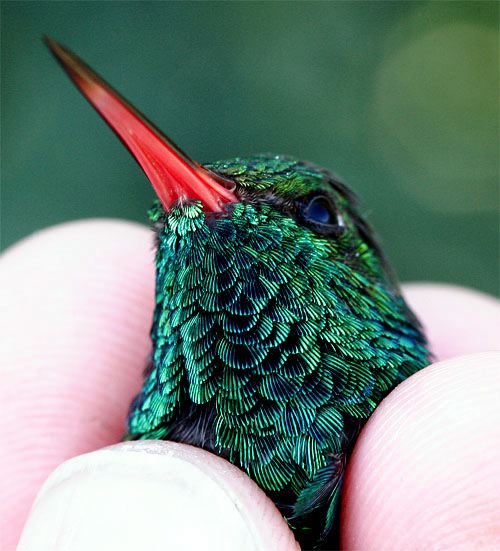 Week One of our annual
Week One of our annual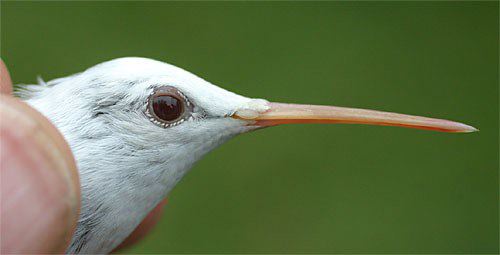
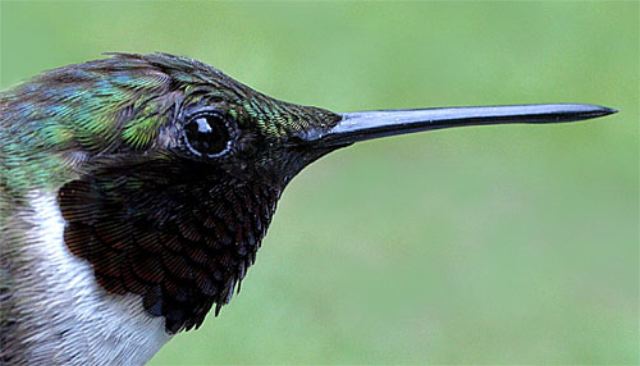
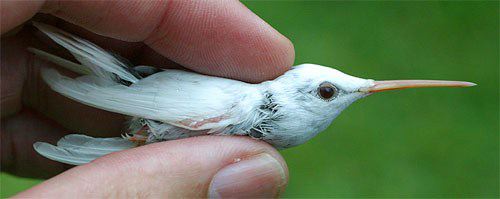
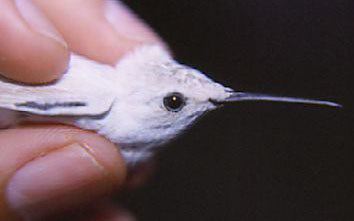 White hummingbirds with nearly black irises and dark feet and bills (left) aren't true albinos. Instead they are described as "leucistic" (loo-KISS-tick), from the same root word as "leucocytes" (white blood cells) and "leukemia" (in which abnormal leucocytes are produced). If pure white birds with pink eyes are "albinos," then we suggest--only partly tongue-in-cheek--that for simplicity's sake white hummers with dark eyes should be called "leucistos."
White hummingbirds with nearly black irises and dark feet and bills (left) aren't true albinos. Instead they are described as "leucistic" (loo-KISS-tick), from the same root word as "leucocytes" (white blood cells) and "leukemia" (in which abnormal leucocytes are produced). If pure white birds with pink eyes are "albinos," then we suggest--only partly tongue-in-cheek--that for simplicity's sake white hummers with dark eyes should be called "leucistos." This featherless area--found in various kinds of birds--reveals the skin of the hummer's wing is black. In the lateral photo of the Durham hummer, that subalular spot is pink, further indicating a lack of melanin in an albino's skin. On "normal" ruby-throats one doesn't notice the apterium because it's surrounded by dark feathers.
This featherless area--found in various kinds of birds--reveals the skin of the hummer's wing is black. In the lateral photo of the Durham hummer, that subalular spot is pink, further indicating a lack of melanin in an albino's skin. On "normal" ruby-throats one doesn't notice the apterium because it's surrounded by dark feathers.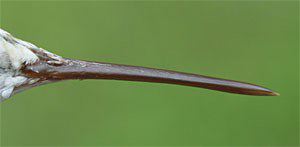 This bird's rectrices were pale brown where they should have been dark green, but the normal white tail tips were delineated as expected in a ruby-throat. We should point out that some leucistos don't have truly black bills and feet; instead these structures are some shade of brown--from tan to chocolate--as shown in a close-up (above left) of the Bethany hummer.
This bird's rectrices were pale brown where they should have been dark green, but the normal white tail tips were delineated as expected in a ruby-throat. We should point out that some leucistos don't have truly black bills and feet; instead these structures are some shade of brown--from tan to chocolate--as shown in a close-up (above left) of the Bethany hummer.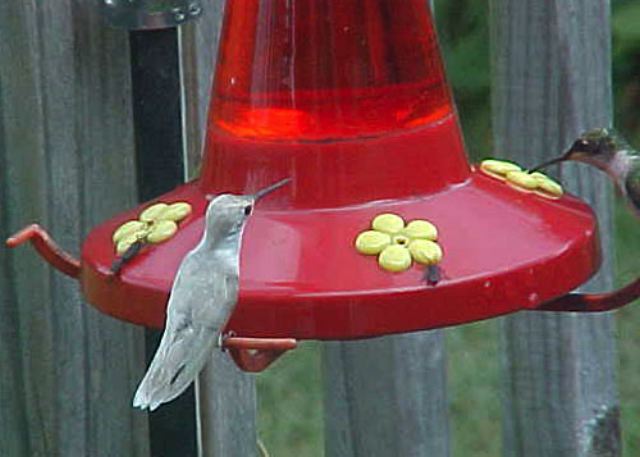
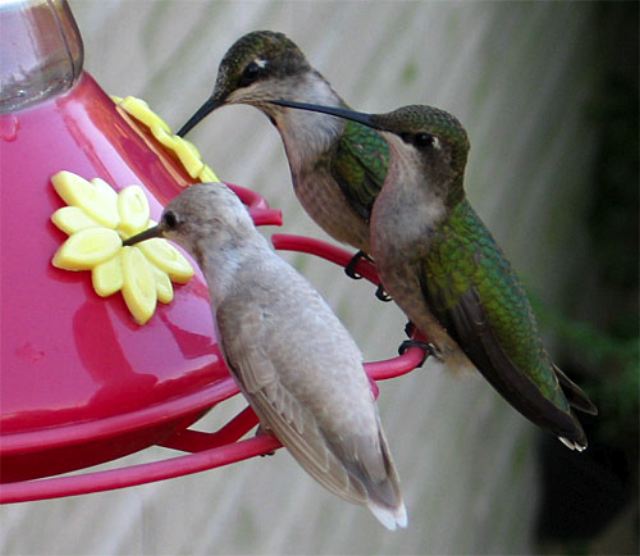
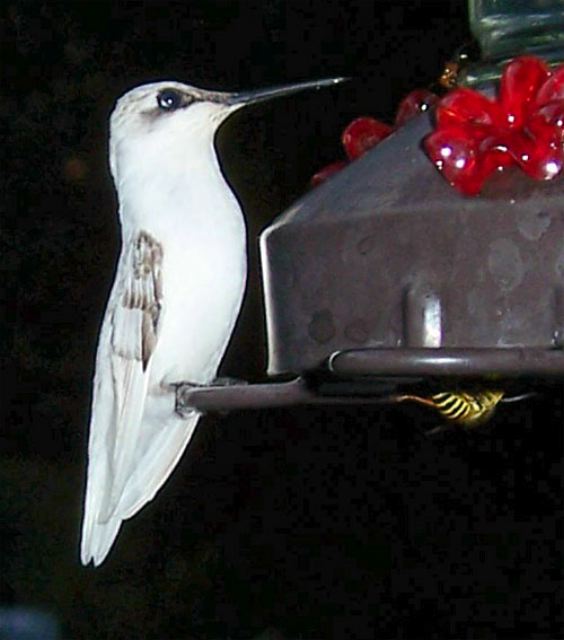
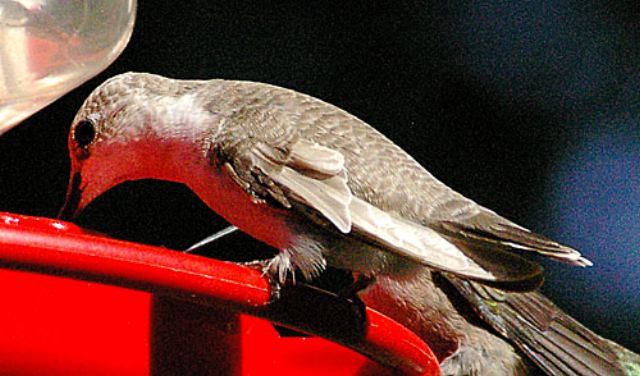
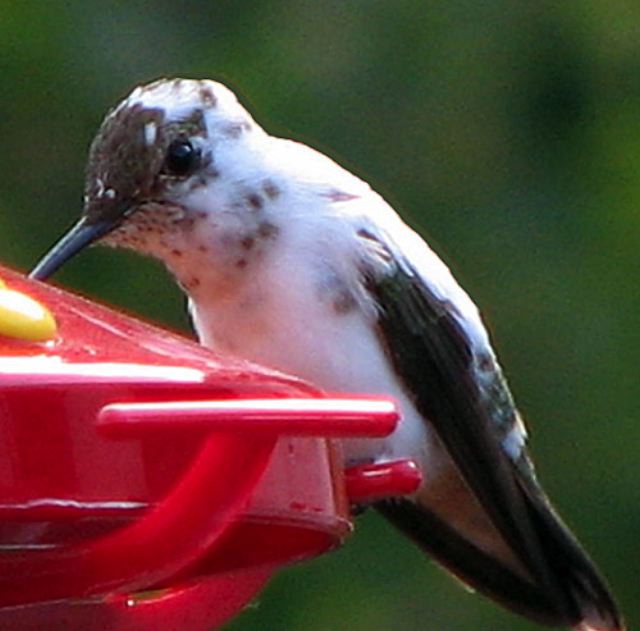
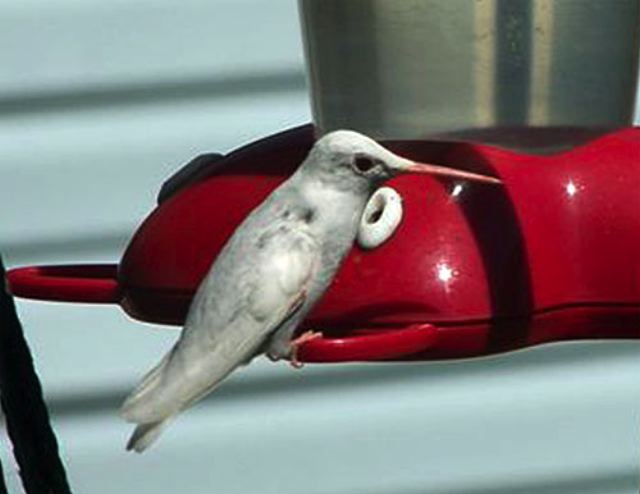
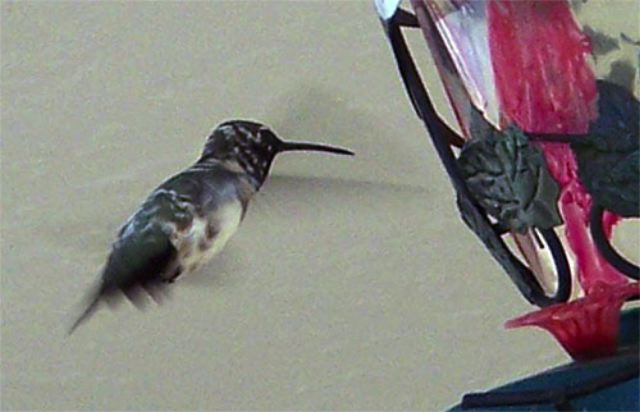
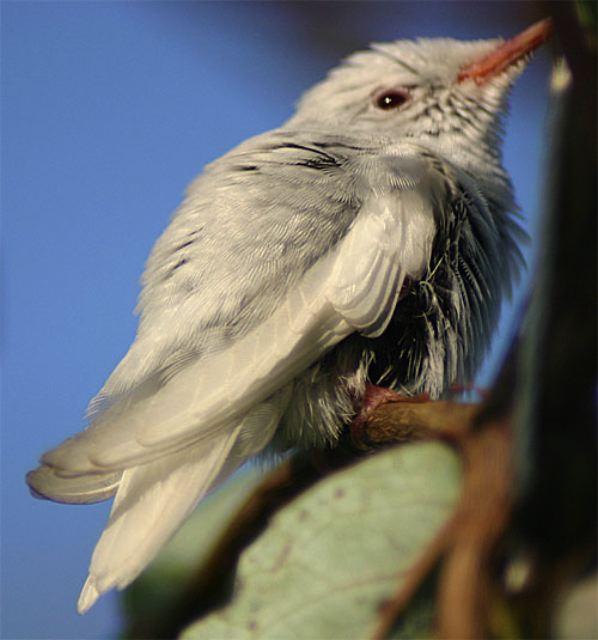
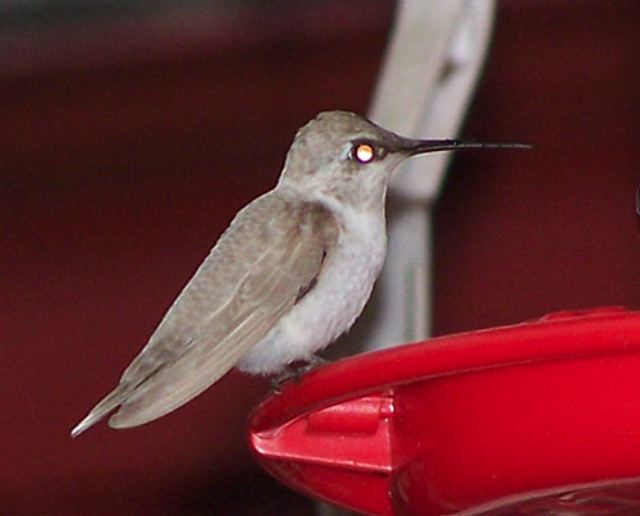


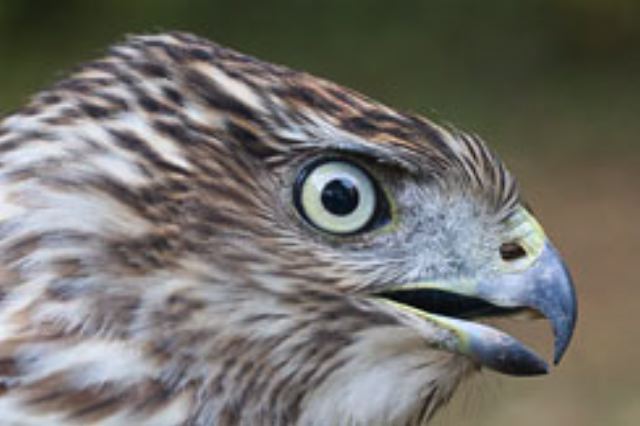
 Please report your
Please report your Oct 15 to Mar 15:
Oct 15 to Mar 15: